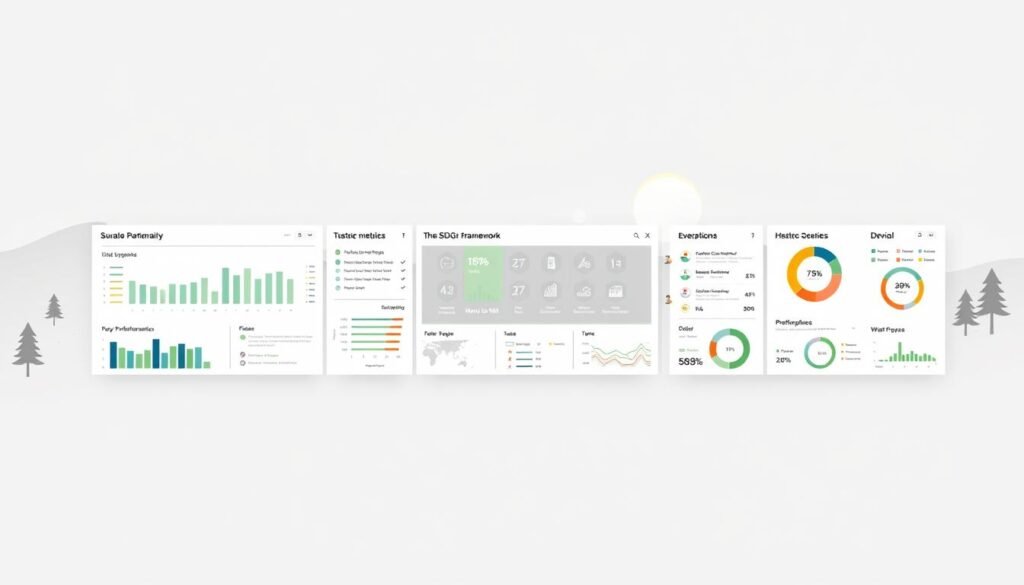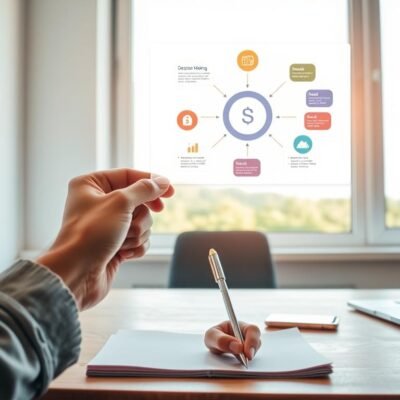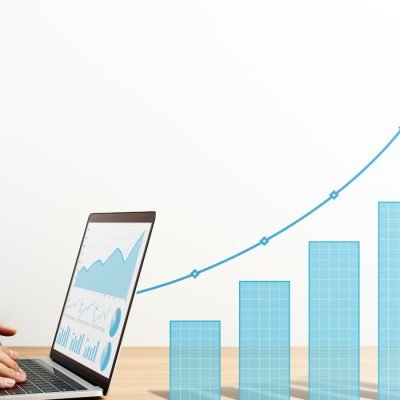Today’s businesses are drowning in data from customers, markets, and operations. Turning this data into action is crucial for staying ahead and being sustainable1. Data-driven decision-making uses analytics to guide choices, from big strategies to everyday tasks. For example, 71% of customers want personalized experiences, pushing brands to use insights1. Sustainable practices depend on these insights to balance profits with environmental care.
Companies using data analytics can cut costs by up to 30% while also boosting revenue and keeping customers2. Tools like Tableau and Power BI help teams see trends, while machine learning predicts what customers might want, like Amazon’s recommendations3. Sustainable business practices need to track things like supply chain efficiency and carbon footprints through data.
Key Takeaways
- Data-driven strategies can increase revenue by 10-30% and cut costs a lot12.
- 67% of executives focus on data-driven growth, but 83% struggle with data skills32.
- Good data governance and AI tools like machine learning are key for accurate insights and sustainable practices3.
- 54% of companies face data silos, slowing down progress toward sustainable goals2.
- Blockchain and IoT technologies improve data transparency, essential for ethical and efficient sustainable business practices3.
Understanding Sustainable Business Practices
Sustainable business practices aim to create value without harming the planet or people. An environmentally friendly business seeks to make profits while protecting natural resources and ensuring fair labor. This way, it ensures success over time without harming social or environmental health.
- Resource efficiency: Using smart sensors to reduce energy and water use saves money and cuts emissions4.
- Waste reduction: Companies like Curbell have recycled 2.2 million pounds of waste, avoiding landfills5.
- Ethical supply chains: Fair labor practices boost brand trust and employee satisfaction4.
- Renewable energy adoption: Switching to wind or solar power reduces fossil fuel use4.
Today, 80% of consumers choose brands based on their eco-conscious practices5. Employees also want to work for companies that care about the environment—70% do5. Businesses that adopt these practices gain a competitive edge, like New Belgium Brewing with its wind-powered operations4.
Even small changes, like replacing old equipment, can make a big difference in energy use and waste reduction5. By embracing these strategies, companies can thrive in a world facing resource scarcity and changing regulations. Eco-conscious practices are now essential for staying competitive.
What Constitutes Sustainable Business Practices?
Going green is more than just caring for the planet. It’s a smart move for success. Companies that use green business solutions like solar power or recycling save money and gain trust. Studies show 64% of people like buying from brands that care about the environment6. Also, 69% of employees want to work for companies that focus on sustainability6.
This shows that sustainable business strategies can be a big plus. They turn doing good into a competitive edge.
Benefits of Implementing Sustainability
Right away, you save money. Using recycled materials or energy-saving tech cuts down on costs. For example, Google is using 34% recycled plastic in its packaging, aiming for 50% by 20256. This move reduces waste and saves money.
More than 90% of companies that go circular see a 30% drop in waste costs6.
When brands match values, customers stick around. 62% of shoppers are ready to change for the planet7. And 70% of employees prefer working for eco-friendly companies6. This builds loyalty: 77% of retail and consumer goods buyers trust brands that are green7.
Investors also look for green. 80% of them consider ESG when making decisions, and 54% believe it boosts returns6. McKinsey found that using data analytics for sustainability pays off6.
Happy employees stick around too. Companies with green programs keep staff longer. 69% of workers want their employers to be eco-friendly6. This reduces turnover costs. Brands like IFO offer better wages, boosting morale and productivity6.
Using data analytics is crucial. It helps track progress and refine strategies. Tools like the U.S. Clean Energy tax incentive help measure savings6. This makes sustainable business strategies both good for the planet and profitable.
Common Misconceptions About Sustainability
Many myths about sustainability stop businesses from being more responsible. People think companies that care about the planet lose money. But, the truth is, companies that focus on sustainability actually make more money. They have 3.7x higher operating margins than those that don’t8.
Also, most shoppers want to buy from companies that care about the environment. In fact, 77% of them do, and 62% are willing to change their ways for the planet9. Even small businesses get it—90% of them worldwide and 99% in the UK see the value in being sustainable810.
- Even old industries like manufacturing can save money by being green. 34% of companies cut costs by using sustainable supply chains9
- Investing in sustainability can pay off big time. IKEA and Ascend show us how, with their innovative ways of using resources9
- Putting ESG into action makes companies stronger, not just a side project8
Tools like tracking carbon and analyzing waste help turn myths into real actions. When 52% of buyers look for eco-friendly products10, being open about your efforts can give you an edge. Sustainability is not a choice—it’s the key to building trust and making more money.
How Data Analytics Can Drive Sustainability
Data analytics makes sustainability goals real. The United Nations has 17 Sustainable Development Goals (SDGs) that need tracking. Companies like Zalando use analytics to check on suppliers’ ESG practices. They look at over 100 global databases to cut risks and boost transparency11.

Important metrics include carbon emissions, supply chain efficiency, and product lifecycle impacts. For instance, tracking Scope 3 emissions shows hidden waste in logistics and production. Here, 45% of supply chain emissions come from transportation and manufacturing12.
- Setting carbon reduction targets in line with the Paris Agreement boosts investor trust11.
- Automated data collection cuts down on manual errors, letting teams focus on key tasks11.
- Predictive analytics forecast environmental impacts, helping businesses tweak strategies before they start11.
AI tools like supply chain control towers watch CO2 levels in real time, allowing for quick changes11. Now, over 60% of consumers look for sustainable products, making ESG reporting a key advantage13.
Good metrics also tackle workforce training gaps. By integrating software systems, companies can meet SDGs, ensuring they follow rules and stay strong over time11. By mixing human insight with AI, firms can turn data into steps toward global sustainability goals12.
Tools and Technologies for Data Analysis
Today’s businesses use advanced tools to make data useful for sustainability. They use cloud-based platforms and AI analytics. These tools help companies track their environmental impact and meet global goals like going net-zero by 205014.
Integrating Data-Driven Practices
Important technologies for sustainable finance include:
- Business intelligence (BI) tools like Tableau and Power BI for visualizing emissions data and cost savings15.
- IoT sensors and carbon calculators that monitor real-time energy use and waste reduction in supply chains14.
- Blockchain platforms ensuring transparency in sourcing materials, such as verifying recycled content in products14.
Companies like IKEA use analytics to measure supplier performance through 12+ environmental metrics, reducing their climate footprint14. Alaska Airlines uses flight path software to cut fuel use by optimizing routes14. Over 90% of firms are now formalizing ESG strategies, but only 9% use dedicated software for this purpose16.
This gap shows a need for tools that link sustainability metrics to financial outcomes, a key part of sustainable finance solutions15.
Emerging tools like digital twins simulate environmental impacts of operations before implementation, while frameworks like the Corporate Sustainability Reporting Directive (CSRD) enforce data-sharing standards14. Even small businesses can start with cloud-based platforms, which 60% of leaders are adopting to reduce costs and meet regulations16. Prioritizing quality data and tailored solutions ensures measurable progress toward both ecological and financial goals.
Best Practices for Data Integration
Data integration is key for sustainable business practices. Companies that get it right make decisions 80% faster and work 20% more efficiently17. But, 50% of businesses still face data silos, which raises costs by 25%17. To overcome these challenges, a unified strategy and cultural shift are needed.
Creating a Data-Driven Culture
Starting this culture involves training programs. 71% of employees want to work for companies that value sustainability18. Regular workshops and clear talks help teams see how data supports environmental and social goals. It’s also important for teams to work together—75% of businesses see better customer experiences with integrated data17.
- Standardize data formats to avoid duplication. Centralized platforms cut operational costs by 25%17.
- Adopt governance frameworks for accurate data. Clear policies help build trust in tracking carbon and waste.
- Train staff with quarterly workshops. 63% of executives see data integration as a key advantage17.
- Use ERP systems to bring data together. These tools cut errors by 30% and support real-time sustainability reports17.
Leaders must lead this change. Companies with strong data cultures see 10% more revenue and stronger brands17. By focusing teams on shared goals, businesses can use data for sustainable practices and long-term success. Teams that share data transparently keep 15% more customers17.
Overcoming Barriers to Integration
Many companies face challenges in combining eco-conscious practices with data-driven strategies. Over 70% of businesses say they have gaps in their sustainability plans. Only 24% have clear plans19. Data silos, old systems, and resistance to change are big obstacles. For example, 65% of companies don’t link management rewards to sustainability goals, making it hard to hold people accountable19.
Technical issues like software that doesn’t work together and old infrastructure slow things down. Cultural barriers include 40% of employees not knowing their company’s sustainability goals19. Smaller businesses often can’t afford the tools they need for advanced analytics. But, there are ways to overcome these problems.
- Start small: Focus on high-impact metrics like carbon emissions first20
- Invest in cross-department training to build data literacy
- Use phased rollouts to avoid overwhelming teams
Top companies like those in the S&P 500 are making progress. 31 have set goals to reach net-zero by using carbon disclosures19. The Deloitte Institute says waiting too long could cost the global economy $178 trillion by 207020. By focusing on clear communication, engaging stakeholders, and setting measurable goals, companies can turn challenges into chances for growth. Taking small steps today lays the groundwork for success in eco-conscious practices in the long run.
Environmental Impact Metrics

For an environmentally friendly business, tracking environmental impact is crucial. It helps reach sustainability goals. Important metrics include carbon emissions, energy use, and water consumption.
Companies measure carbon footprints by counting CO2, methane, and nitrous oxide emissions21. Energy efficiency is tracked in kilowatts per unit of output. Water usage is measured in liters per product or facility gallons per day, showing where to improve.
- Carbon emissions: Measured in metric tons to align with science-based targets21.
- Water efficiency: Buildings in the U.S. now use 980 million gallons daily, up 9% yearly21.
- Waste reduction: Companies cutting waste by 20% through EIAs improve sustainability22.
Social responsibility indicators include employee engagement and community impact. Over 40% of millennials prefer jobs with eco-focused companies, even if it means lower pay21. CRM tools like Salesforce and HubSpot help track customer preferences for sustainability, boosting loyalty by 25%22.
Transparency is essential—86% of firms now publish sustainability reports, but only 15% meet ISSB standards23. By using metrics like renewable energy adoption and waste reduction, businesses gain trust and reduce risks. A data-driven approach ensures environmentally friendly business practices meet global standards and stakeholder expectations.
Economic Sustainability Measures
Smart businesses are now focusing on green business solutions. They aim to make money while protecting the environment. By saving on energy costs and selling eco-friendly products, they show that being green is good for business. Tools like machine learning help companies like Schneider Electric reduce waste worldwide1.
- Cost savings from efficiency upgrades average 10-20% via optimized resource use2
- ROI on sustainable R&D shows 10-15% higher ad performance through targeted campaigns2
- Carbon pricing models reduce stranded asset risks by 40% when integrated into budgets3
Netflix uses viewer data to make shows that people love, saving money on production3. This approach helps companies like Unilever meet both profit and environmental goals. By tracking how much material they recover and the strength of their supply chains, they ensure they can keep going strong. Amazon looks at what people buy to cut down on emissions and grow its market1. These smart moves make investors more confident and open up new ways to make money in the green economy.
Aligning Business Goals with Data Insights
Aligning business goals with data insights is key to ethical operations. Data analytics shows how to meet today’s needs while planning for tomorrow. Companies using predictive analytics can spot risks like climate impacts early on. This helps them avoid big losses, like the $178 trillion global economic loss by 2070 without cutting emissions20.
This foresight makes ethical practices a core part of their strategies.
Quick wins keep momentum going. Service providers see a 20% boost in customer satisfaction with feedback systems24. Manufacturing firms cut costs by optimizing processes, seeing ROI in 18 months24. These wins fund bigger sustainability projects and prove value to stakeholders.
Frameworks like the IFRS Sustainability Disclosure Standards help plan for the long term20. Having leaders like CFOs oversee sustainability ensures accountability20. Data visualizations make sharing insights easy, making goals clear to everyone.
Aligning with stakeholder priorities helps avoid mistakes. It ensures strategies reflect everyone’s values20.
Data-driven strategies lead to lasting ethical business operations. By focusing on key metrics, teams avoid feeling overwhelmed20. Balancing short-term gains with long-term vision makes companies resilient. They see benefits like reduced risks, improved efficiency, and stronger brand loyalty. This approach turns sustainability into a competitive advantage20.
Case Studies of Successful Data-Driven Planning
Companies like Amazon show how data analytics can change sustainability efforts. They track customer behavior and improve supply chain efficiency. This leads to lower emissions and higher profits. Amazon is a top example of a socially responsible company25.
Ariel’s #WashColdChallenge campaign is a great example of using data creatively. It got over 1 million pledges, leading to a £100,000 donation for climate work. The campaign showed how it could save energy in homes26.
This effort appeals to 62% of young people who want to buy from sustainable brands26.
- Energy savings: Small businesses using smart meters cut their bills by 18-25% thanks to data25.
- Transparency: IoT sensors in logistics routes cut nitrogen dioxide emissions by 10% when people worked from home26.
- Investor trust: Companies that share verified sustainability reports get 12% more investment. This was seen in Q4 2021’s $142B green fund influx26.
Data tools like AI predictive models and blockchain traceability help socially responsible companies make real changes. These stories show that adding sustainability metrics is not just right—it’s also smart and profitable.
Importance of Transparency in Reporting
Transparent sustainability reporting is key to building trust and making real progress toward sustainable development goals. Companies share data on their environmental, social, and economic actions. This way, they meet global standards and satisfy their stakeholders. For instance, Patagonia’s Footprint Chronicles tells stories about their supply chain ethics, showing how openness builds brand loyalty. This method also supports sustainable business strategies that aim for both profit and purpose27.
Methods for Effective Sustainability Reporting
Good reporting mixes clear data with easy access. Tools like Microsoft’s carbon tracking dashboards make complex info simple. Patagonia and Unilever show that 94% of consumers prefer brands that are open, leading to a 25% increase in loyalty28. Also, 70% of employees think transparency helps in making better decisions29, helping teams work together toward sustainability goals.
Rules like the SEC’s climate disclosure rules require precise data. Companies like BlackRock, planning to grow their ESG funds, focus on clear reports to meet investor needs27. Even when facing issues, like supply chain problems, being open is key—89% of consumers trust brands that own up to mistakes29.
The future depends on innovation in reporting. AI tools will make reports faster and more accurate. The UN’s IPCC calls for quick climate action, and transparency keeps strategies aligned with sustainable development goals. By using open communication and data-driven stories, companies turn reporting into a path for progress, not just a rule to follow.





